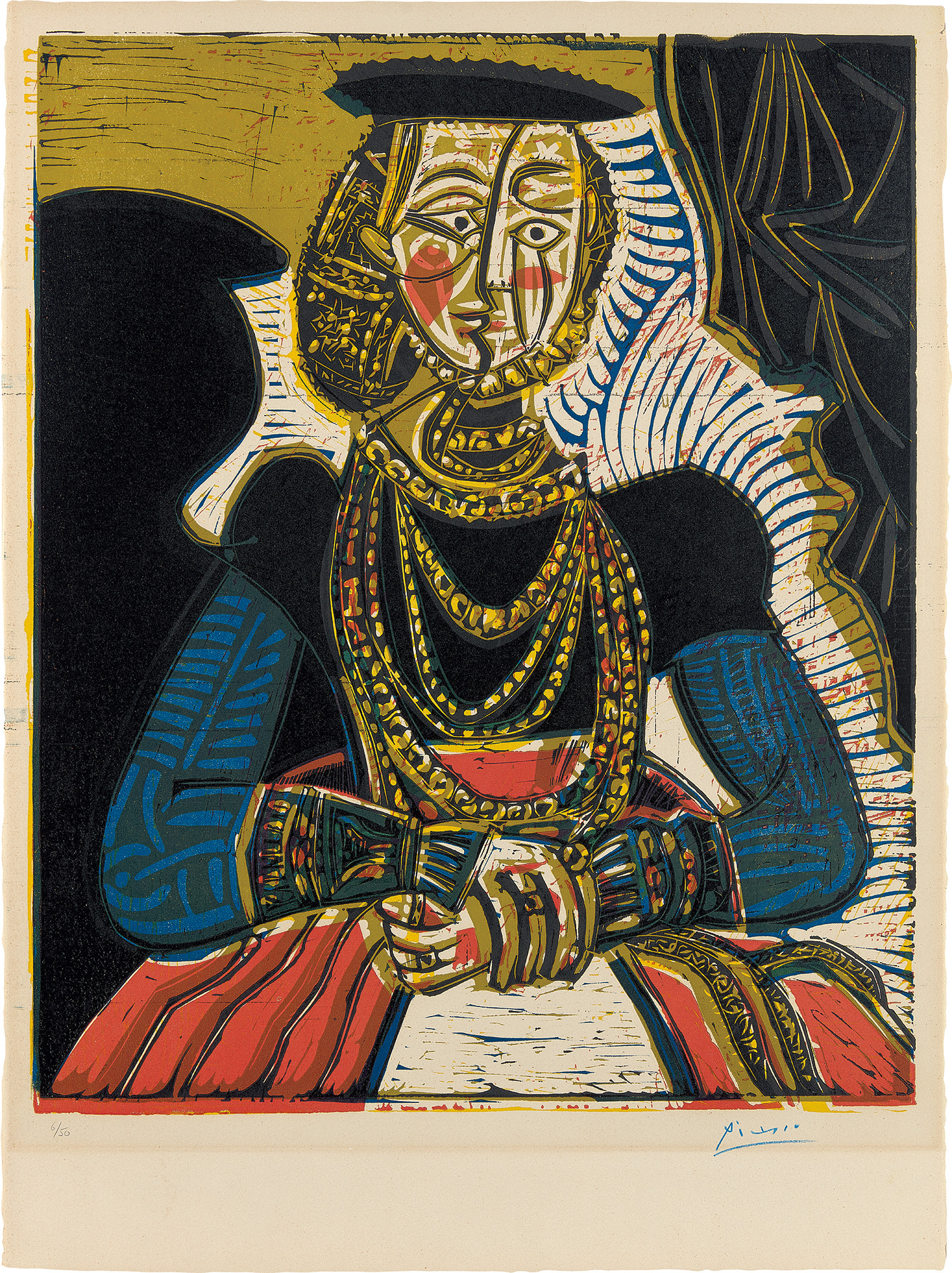

11
Pablo Picasso
Portrait de jeune fille, d’après Cranach le Jeune (Portrait of a Young Woman, After Cranach the Younger)
S. 30 x 22 1/2 in. (76.2 x 57.2 cm)
完整圖錄內容
The layering of these five elaborately cut blocks combines to create his most painterly of prints, transforming the old master’s portrait into a modern mastery of rhythm and meaning. After finishing this print, Picasso found the traditional, multi-block process too labor-intensive and complicated, so he invented a ‘reduction’ printing method using just one piece of linoleum per print for future linocut editions, making this work all the more iconic. As explained in Cubism and its Legacy: The Gift of Gustav and Elly Kahnweiler:
Although he had already made one linocut in 1939 (‘Pour la Tchécoslovaquie. Hommage à un pays martyr’), Picasso only started exploring this technique in earnest in 1953-4, with….Hidalgo Arnéra in Vallauris. At this time, he began to experiment with making linocuts in different colors on separate blocks, which he would then superimpose on the same sheet of paper. He first attempted ‘Portrait of a Woman after Cranach the Younger’ in two colours on 3 July 1958, but the following day returned to the same subject more ambitiously. On 4 July he made five different linoleum blocks – sepia, yellow, red, blue and black – to be superimposed on each other in that order. He then proceeded to print different proofs, in the process making two different states of the colour blocks and three of the black in order to arrive at the final image.
(Giorgia Bottinelli, Pablo Picasso, in Jennifer Mundy, Cubism and its Legacy: The Gift of Gustav and Elly Kahnweiler, Tate Modern, London, 2004, pp. 88-90, 100-1.)
Portrait de jeune fille, has been written about extensively and exhibited in institutions and galleries worldwide. This print is included in many surveys on Picasso and portraiture chiefly because Picasso was able to synthesize critical elements so successfully: image, history, theory, complexity, scale and distinguish it with his unique dose of independent vitality. Picasso’s dealer Daniel-Henry Kahnweiler has explained the genesis of this work:
‘One of Picasso’s notable characteristics was his need to transform existing works of art, to compose “variations on a theme”, as it were. His point of departure was often simply a reproduction in a book; or even a postcard sent by myself, such as ‘Cranach the Younger’s Portrait of a Woman’ [1564] in Vienna [collection Kunsthistorisches Museum], which became his first linocut in color. Among other things, what struck him in particular about this painting was the way the woman’s shadow “rhymes” with the upper part of her body….This need to transform was certainly an important characteristic of Picasso’s genius.’
(Daniel-Henry Kahnweiler, Introduction: A Free Man, in Roland Penrose and John Golding, Picasso 1881/1973, London, 1973, pp. 8-9.)
Picasso was a passionate student and proponent of European painting, wanting to reinvigorate these traditions more than any other 20th century artist. His love of replaying the roles of earlier artists reached its height in the 1950s when he devoted himself in painting, drawing, sculpture and printmaking to reworking masterpieces.
Cranach the Elder was second only to Rembrandt of the Northern masters who inspired Picasso. The rich territory that he was to mine intensively in his ‘old master period’ follows Cranach with El Greco and Courbet in 1950 and continues with Cranach the Younger and Van Gogh as well as Goya, Poussin, David and Degas….Picasso is taking on the artists who for him were still alive, and who he said he felt were ‘all standing behind me watching me at work’. At once reverential and competitive, Picasso’s relationships with his ‘collaborators’ became a means of appropriating and fusing the disparate elements of their great themes, in order to rewrite them in his own visual language. These homages affirm Picasso’s roots in the classical tradition in which imitation and originality are recognized as reciprocal parts of each other, and situate him firmly within the lineage of great artists.
(Elizabeth Cowling, Picasso: Challenging the Past, National Portrait Gallery, London 2009, p.13.)
Portrait de jeune fille, d’après Cranach le Jeune is the tour de force of Picasso’s print oeuvre. The print’s inventiveness both in form and medium are indicative of Picasso’s pursuit and ability to uncover something new. While it is a nod to one of his artistic idols, the image he created is imbued with a timelessness and an undeniable freshness.
Pablo Picasso
Spanish | B. 1881 D. 1973One of the most dominant and influential artists of the 20th century, Pablo Picasso was a master of endless reinvention. While significantly contributing to the movements of Surrealism, Neoclassicism and Expressionism, he is best known for pioneering the groundbreaking movement of Cubism alongside fellow artist Georges Braque in the 1910s. In his practice, he drew on African and Iberian visual culture as well as the developments in the fast-changing world around him.
Throughout his long and prolific career, the Spanish-born artist consistently pushed the boundaries of art to new extremes. Picasso's oeuvre is famously characterized by a radical diversity of styles, ranging from his early forays in Cubism to his Classical Period and his later more gestural expressionist work, and a diverse array of media including printmaking, drawing, ceramics and sculpture as well as theater sets and costumes designs.